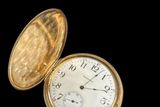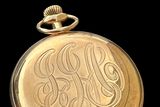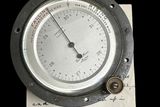Titanic memorabilia still big business as passenger’s gold watch sells for €1.4m at auction




The Titanic is unsinkable at auction. On April 27, a gold watch that survived the sinking of the White Star Line ship in 1912 sold for £1.2m (€1.4m) at Henry Aldridge & Son in Wiltshire, England.
It carried an estimate of £100,000 to £150,000 (€117,000 to €175,000) and now holds the record for the highest price ever paid for Titanic memorabilia.
The previous record holder was the violin played by the band leader Wallace Hartley as the ship went down, which sold at the same auction house for £1.1m (€1.28m) in 2013.
The leather case that held that instrument sold on April 27 for £360,000 (€421,000), but sadly, has not been reunited with the violin. It’s gone to another home.
The gold watch was prised from the cold dead pocket of John Jacob Astor IV (1864-1912), an extremely rich American businessman who died in the sinking of the Titanic.
He sounds like a debonair individual, described as helping his wife into a lifeboat, then casually smoking a cigarette.
John Jacob Astor IV and his wife Madeline
His body was recovered by the CS MacKay-Bennett on April 22 and identified by the initials sewn on to the lapel of his jacket. The crew would have identified him as a rich person.
As well as the watch, he wore gold cuff links and a diamond ring, and carried $2,440 in notes. At the time, he was probably one of the wealthiest people in the world.
The watch, a 14kt, 17 jewel Waltham pocket watch with JJA engraved on the case, was fully restored and worn by Astor’s son, Vincent. It must have been a good conversation piece.
Read more
Astor’s young wife Madeline survived the sinking. She was five months pregnant and left the vessel on lifeboat 4.
The couple were returning from an extended honeymoon in Europe and Egypt, following their scandalous marriage. He was 47 and recently divorced. She was 18 and younger than Astor’s son.
Shunned by polite society, the couple made friends with the Irish-American activist Margaret Brown, who also travelled on the Titanic. She acquitted herself well during the rescue operation. On landing from the Carpathia, she reputedly declared herself unsinkable and later became known as “the unsinkable Molly Brown”.
Until then, Mrs Brown had been shunned by the high-flying social set, mainly for her parents being Irish and she being Catholic. The Denver Times reported: “Her spelling was faulty, her wardrobe garish, her mother smoked a pipe.”
The watch is a 14kt, 17 jewel Waltham pocket watch with JJA engraved on the case
The glamour of surviving the Titanic worked in her favour and she used her fame to promote her activism and philanthropy.
In 1932, she was awarded the French Legion of Honour for her work in organising female ambulance drivers, nurses and food distributors for the Red Cross during the First World War.
Titanic’s senior wireless operator Jack Phillips also died in the sinking. Phillips was employed by the Marconi Company and used a Marconi wireless telegraph machine to send distress calls to nearby ships, which helped to save 700 people in lifeboats.
A Marconi spark coil transmitter, similar to the one used in the Titanic, sold for €2,600 at Sheppard’s Auction House, County Laois, in March.
A rare press photograph included in the sale at Henry Aldridge & Son showed Phillips and other operators at the Marconi station outside Clifden, Connemara, in 1908.
It was published in the Daily Mirror under the title ‘Mr Marconi’s Triumph: Pictures of the Irish Station’. Phillips, who is recorded at the Clifden station in the Irish census of 1911, described it as a “dreary hole”.
Short and Mason aneroid barometer from Ernest Shackleton's cabin
The photograph, which fills a gap in the historical record, sold for £1,100 (€1,285).
While anything that travelled on the Titanic is pure gold at auction, any items related to the Irish polar explorer Ernest Shackleton will also create a flurry.
A Short & Mason aneroid barometer that hung in Shackleton’s cabin on board R.Y.S. Quest (1921-22) was included in the sale. It sold for £38,000 (€44,440), far exceeding its estimate of £5,000 to £8,000 (€5,840 to €9,350).
The barometer was a poignant piece. The Shackleton-Rowett Antarctic Expedition was Shackleton’s last. He was poetic to the end.
On January 4, he wrote in his diary: “The old smell of dead whale permeates everything. It is a strange and curious place... A wonderful evening. In the darkening twilight, I saw a lone star hover, gem-like above the bay.”
He died of heart failure in his cabin in harbour at South Georgia on January 5, 2022. His body was sent halfway back to England, but then returned to South Georgia where it was buried in the Norwegian cemetery at Grytviken at his widow’s request.
See henryaldridge.com.
Join the Irish Independent WhatsApp channel
Stay up to date with all the latest news





















